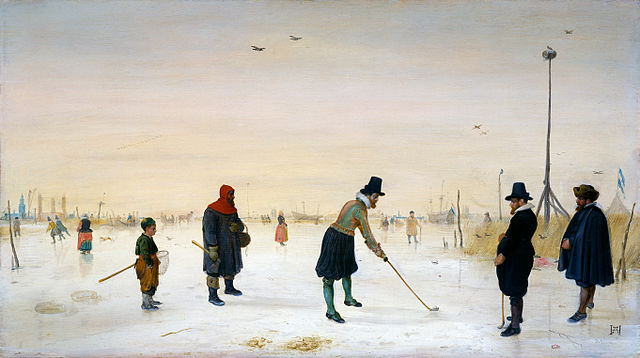
Kolf (or kolven, verb) was a sport with characteristics of golf and ice hockey, played in the Netherlands as early as the 13th century. In this game, players took turns using iron-headed clubs to strike a small ball toward a target, typically a stake or a hole. During the winter, kolf was typically played on ice, though it took place on city streets and courts for the rest of the year. The sport was typically played a smaller scale than modern golf – perhaps more comparable to mini golf. However, kolven was sometimes taken off the ice and out of the city into open fields where the scale would have been similar to that of modern golf.
Kolf may have contributed to the development and history of golf in Scotland, though this is subject to much debate. As golf appears in Scotland as early as the 15th century, it is possible that the fairly similar game of kolf influenced some of its development. Other theories put forth that kolf is more closely related to ice hockey and has nothing to do with the development of golf. The similarities in names and characteristics of the sports, as well as the general geographical proximity of the Scotland and the Netherlands, suggest otherwise.
Origins and History
The earliest literary reference to kolf lies in a poem written by poet Jacob van Maelant in 1261, though it refers to it only as a game played with a club. Other references speckled throughout the ensuing few centuries are similarly absent of details, not providing a full picture of the sport or its origins. It is possible, though not widely accepted, that the Chinese sport chuiwan influenced the development of kolf, as the former is older yet incredibly similar to medieval descriptions of the latter. However, a lack of hard evidence for such a connection means this theory is primarily speculation.
By the 16th and 17th centuries we get a clearer picture of kolf and how it was played at the time, though this may not necessarily reflect how it was played in centuries prior. Throughout the following centuries, kolven was narrowed smaller and smaller in scale and eventually walled indoors.
How to Play
The original rules of kolf have likely not been pieced together in full, but the gist of the game is as follows. A small number of players, typically four, would take turns hitting a small ball toward a target. This target was typically a stake or hole a few yards away, though when the game was played in open fields during warm seasons, it could be a far distance away, much like within modern golf. In the winter, this target would typically be a stake in the ice. In all these variations, the goal was to reach the target with as few strokes as possible.
Today, a modern version of kolf is played in the Netherlands, taking place indoors on a 19- by 5.5-yard solid court with a pole toward one end serving as a target. The goal is to get the ball as close to the pole as possible, using rings painted around it to determine scoring.
Equipment

Paintings of kolven from the 17th century, such as the one to the right, typically depict clubs with wooden shafts and iron heads, similar in shape to those used for golf today. Some accounts suggest early versions of kolf may have used clubs made entirely of wood.
The ball was around the same size as a golf ball, though typically made of wood or, occasionally, leather stuffed with wool. Throughout the following centuries, this ball became bigger and bigger. In the modern rendition of kolf, the ball is closer to a baseball in size and is typically made of rubber.
[raw_html_snippet id=”bib”]
Bohn, M. K. (2007). Money golf: 600 years of bettin’ on birdies. Washington, D.C.: Potomac Books.
Graves, R. M., & Cornish, G. S. (2002). Classic golf hole design: Using the greatest holes as inspiration for modern course. Hoboken, NJ: J. Wiley & Sons.
Shephard, R. J. (2015). An illustrated history of health and fitness, from pre-history to our post-modern world. Cham, Switzerland: Springer.
van Hengel, S. J. (1985). Early golf. Liechtenstein: Frank P. van Eck.
[raw_html_snippet id=”endbib”]